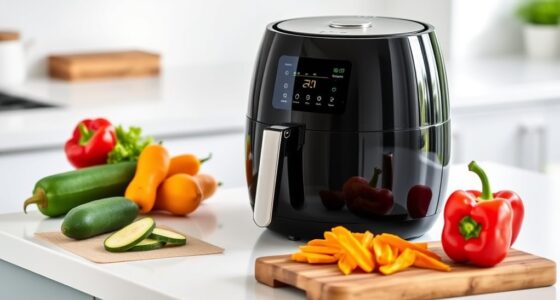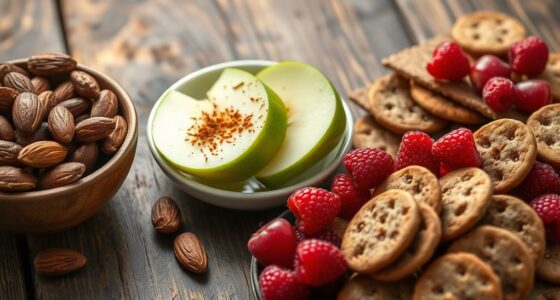To preserve nutrients while air frying, choose fresh, high-quality ingredients and keep them properly stored and prepped. Use moderate temperatures and avoid overcooking by preheating your air fryer and cooking in small batches. Incorporate nutrient-rich seasonings like herbs and citrus, and consider steaming or blanching vegetables beforehand to minimize nutrient loss. Ensuring proper airflow, minimal oil, and gentle reheating also helps retain essential nutrients—continue exploring for more tips to maximize your healthy meals.
Key Takeaways
- Use moderate temperatures (350°F–375°F) and preheat the air fryer to minimize nutrient degradation during cooking.
- Avoid overcrowding the basket to promote even heat circulation and reduce cooking time, preserving sensitive nutrients.
- Incorporate nutrient-rich seasonings like herbs, spices, and citrus to boost vitamin and antioxidant levels.
- Keep ingredients dry before cooking to prevent moisture loss and nutrient leaching.
- Opt for gentle reheating at low temperatures to maintain nutrient content and flavor.
Choose Fresh, Quality Ingredients

Choosing fresh, high-quality ingredients is crucial for preserving nutrients during air frying. When you start with fresh produce and meats, you’re giving your body the maximum nutritional benefit. Fresh ingredients retain more vitamins, minerals, and antioxidants compared to older or processed options. Select vibrant vegetables, firm fruits, and lean cuts of meat or fish for ideal results. Avoid ingredients that look wilted, discolored, or damaged, as they often lose essential nutrients. Properly stored ingredients also help, so keep produce refrigerated and use it before its expiration date. By prioritizing freshness and quality, you ensure that your air-fried meals are not only delicious but also packed with the nutrients your body needs. This simple step makes a significant difference in healthy cooking.
Use Appropriate Cooking Temperatures

Setting the right temperature helps you cook food thoroughly without destroying valuable nutrients. Using too high heat can lead to overcooking and nutrient loss, while too low may leave food underdone. By choosing ideal temperatures, you guarantee your meals stay nutritious and flavorful.
Choosing Optimal Temperatures
To preserve the nutrients in your food during air frying, selecting the right cooking temperature is crucial. Aim for moderate temperatures, typically between 350°F and 375°F, to retain vitamins and minerals without overcooking. Higher temperatures can break down sensitive nutrients like vitamin C and certain antioxidants, reducing their benefits. Use your air fryer’s temperature controls to set precise heat levels, and avoid pushing it to maximum settings unless necessary. Adjust temperatures based on the type of food—lighter items like vegetables often need lower temperatures, while denser foods like meats may require slightly higher heat. Monitoring and choosing ideal temperatures helps you cook efficiently while maintaining the nutritional value of your meals. Proper temperature management can also help maximize nutrient retention during cooking. Additionally, understanding the role of heat in nutrient degradation allows you to make more informed cooking choices. Proper temperature control is especially important because it minimizes nutrient loss during the cooking process. Remember, a balanced temperature prevents nutrient loss and supports healthier eating habits. Incorporating proper kitchen techniques can also help maximize nutrient retention during cooking.
Avoiding Overcooking
Since overcooking can quickly deplete nutrients and ruin texture, it’s essential to use appropriate cooking temperatures in your air fryer. Keep the temperature moderate to prevent burning or drying out your food. Use a thermometer if needed to guarantee accuracy, especially when cooking delicate items like vegetables or fish. Follow recommended temperature guidelines for different foods to avoid overcooking. Check your food a few minutes before the suggested cook time to prevent unnecessary exposure to heat. Remember, lower temperatures generally preserve more nutrients and maintain better texture. Adjust cooking times accordingly if you’re cooking multiple batches. Additionally, understanding the nutrient preservation techniques can further enhance your ability to maintain food quality during air frying. Incorporating temperature control skills into your cooking routine can significantly improve nutrient preservation and overall meal quality. Employing proper cooking methods helps minimize nutrient loss and ensures your meals are both delicious and nutritious.
Minimize Cooking Time

To preserve nutrients, you should aim to minimize cooking time by using high heat efficiently and preheating your air fryer. Avoid overcrowding the basket, which can slow down cooking and extend exposure to heat. Keeping these tips in mind helps you cook quickly while maintaining the nutritional quality of your food. Additionally, understanding best cooking practices can further help in retaining essential nutrients during air frying. Being aware of regional resources and local techniques can also optimize your cooking methods for better nutrient preservation. Incorporating sound healing science principles, such as maintaining proper cooking temperatures, can support the retention of delicate nutrients in your food. Monitoring operating hours for your equipment ensures consistent results and minimizes nutrient loss caused by inconsistent cooking conditions.
Use High Heat Efficiently
Using high heat effectively in air frying can substantially reduce cooking time, which helps preserve nutrients. When you set your air fryer to a higher temperature, the food cooks faster, minimizing nutrient loss caused by prolonged heat exposure. To do this efficiently, avoid overcrowding the basket, ensuring hot air circulates evenly. Keep an eye on the cooking process, as higher temperatures can quickly overcook or burn food if left unattended. Use the recommended temperature settings for different ingredients, and adjust based on thickness or size. By leveraging high heat properly, you cut down cooking time without sacrificing quality, helping to lock in vitamins and minerals that degrade during extended cooking. This method maximizes nutrient retention while ensuring your food is crispy and delicious. Additionally, selecting appropriate temperature ranges for each type of food can further enhance nutrient preservation and overall cooking efficiency. Being aware of food-specific cooking guidelines can also help prevent nutrient loss during the process. Incorporating proper preheating techniques can further optimize cooking times and nutrient retention. Utilizing smart temperature control features available on many modern air fryers can also help maintain consistent heat levels, further protecting nutrients.
Preheat for Quick Cooking
Preheating your air fryer before cooking is a simple step that can substantially reduce overall cooking time. When you start with a hot oven, food begins cooking immediately, which helps lock in nutrients and moisture. This quicker process means less exposure to heat, preserving more vitamins and minerals. Additionally, preheating ensures even cooking, preventing cold spots that can extend cooking time. To preheat, set your air fryer to the desired temperature and let it run for 3-5 minutes before adding your food. This small step can make a significant difference in how efficiently your meal cooks, saving you time and helping retain the nutrients that might otherwise degrade with prolonged heat exposure. Moreover, preheating can improve the cooking efficiency of your air fryer, making it a more environmentally friendly option by reducing energy waste.
Avoid Overcrowding Basket
Overcrowding the air fryer basket can substantially increase cooking time and compromise food quality. When you add too much food at once, hot air can’t circulate properly, leading to uneven cooking and longer times. To preserve nutrients and guarantee your food cooks efficiently, space out items in a single layer. Avoid piling or stacking ingredients, as this traps moisture and prevents crispiness. Instead, cook in batches if needed, allowing hot air to reach all surfaces. Proper spacing not only shortens cooking time but also helps retain nutrients by preventing overexposure to heat. Additionally, proper airflow management ensures optimal cooking conditions and better nutrient retention. Adequate air circulation is essential for evenly cooked, flavorful, and nutrient-rich meals. Keep the basket less crowded for better airflow, more even results, and healthier, nutrient-rich meals. Proper spacing is key to preserving flavor, texture, and nutritional value.
Incorporate Proper Prepping Techniques
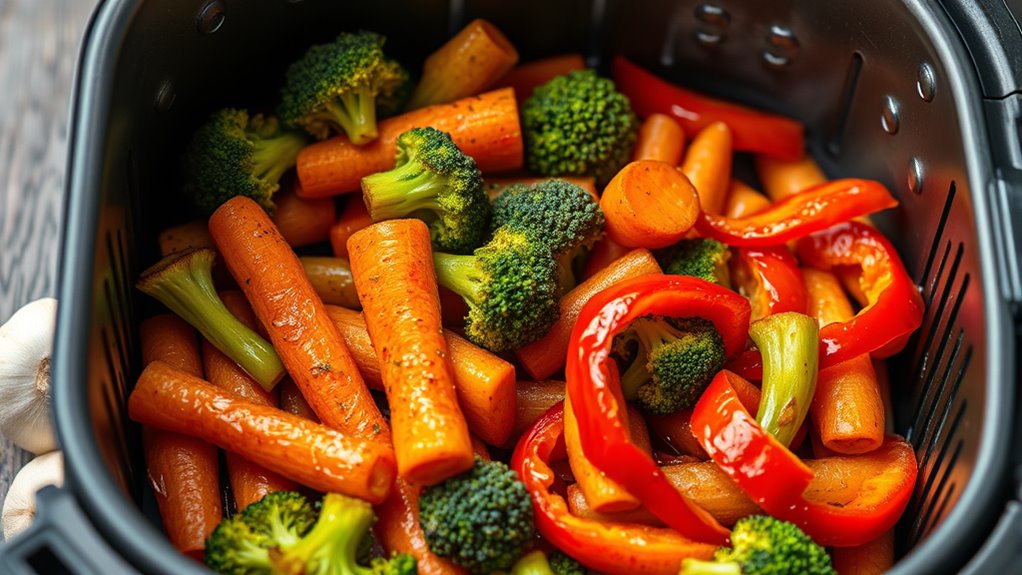
To preserve nutrients during air frying, proper prepping techniques are essential. Start by thoroughly washing fruits and vegetables to remove dirt and bacteria, which helps retain their natural vitamins. When peeling produce, do so gently to avoid losing nutrient-rich layers. Cutting ingredients into uniform sizes ensures even cooking, preventing overcooking or undercooking that can degrade nutrients. Marinate or season foods lightly to avoid excessive salt or sugar that may diminish health benefits. Additionally, consider pre-soaking certain vegetables, like kale or spinach, to remove bitterness and improve nutrient absorption. Always pat foods dry before placing them in the air fryer, as excess moisture can lead to uneven cooking. Proper prepping helps lock in nutrients and ensures your meals remain healthy and flavorful. Furthermore, understanding how climate control technologies can optimize kitchen environments may help maintain the freshness and nutritional quality of your ingredients.
Use Minimal Oil and Moisture

Using minimal oil and moisture during air frying helps preserve the natural nutrients in your foods. When you add too much oil or moisture, it can dilute essential vitamins and minerals, reducing the overall nutritional value. Instead, lightly spray or brush your ingredients with a small amount of oil, just enough to promote browning and crispiness without excess. Keep foods dry before placing them in the air fryer to prevent unnecessary steaming or sogginess. This approach maintains the food’s natural texture and flavor while protecting delicate nutrients from leaching out. Additionally, understanding nutrient preservation techniques highlights the importance of preserving value, much like maintaining the nutritional integrity of your meals. By controlling oil and moisture levels, you ensure your meals stay healthier and more nutrient-dense, allowing you to enjoy flavorful dishes without sacrificing their nutritional integrity.
Opt for Steaming or Blanching Before Air Frying
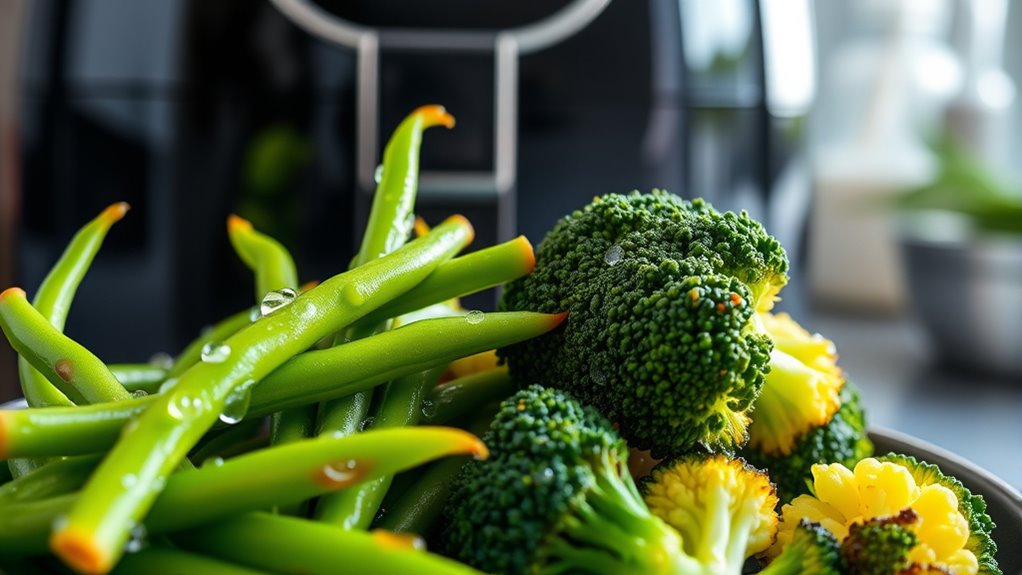
Opting for steaming or blanching before air frying can help preserve nutrients by gently cooking foods and reducing their moisture content. Steaming softens vegetables without exposing them to high heat, which minimizes nutrient loss. Blanching involves briefly boiling foods then quickly cooling them, halting enzyme actions that can degrade nutrients. Both methods lower the moisture level, making foods less prone to nutrient leaching during air frying. This process also softens tough fibers, allowing heat to penetrate more evenly. As a result, you retain more vitamins, minerals, and antioxidants compared to direct air frying. Additionally, pre-treating with steaming or blanching can improve texture and flavor, enhancing your dish without sacrificing nutritional value. It’s a simple step that maximizes health benefits while preparing foods for air frying.
Incorporate Nutrient-Rich Seasonings and Marinades
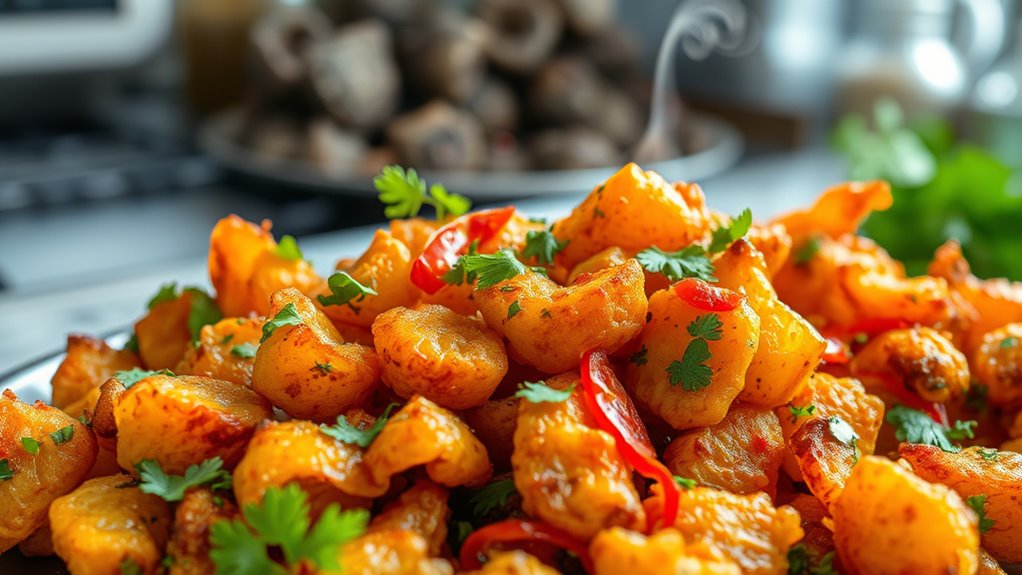
After steaming or blanching your vegetables to preserve nutrients, the next step is to enhance their health benefits and flavor with nutrient-rich seasonings and marinades. Use herbs like parsley, cilantro, or basil to add antioxidants without extra calories. Incorporate spices such as turmeric, paprika, or cumin, which contain anti-inflammatory compounds. Citrus juices like lemon or lime boost vitamin C and improve flavor. Marinate your vegetables in a mixture of olive oil, vinegar, and herbs to infuse nutrients and tenderize. Avoid sugary or overly salty marinades that can diminish health benefits. By choosing vibrant, nutrient-dense ingredients, you’ll maximize flavor and nutritional value without compromising the integrity of your vegetables during air frying.
Avoid Overcrowding the Air Fryer Basket

To guarantee your vegetables cook evenly and retain their nutrients, it’s important not to overcrowd the air fryer basket. When too much fits, air can’t circulate properly, leading to uneven cooking and nutrient loss. To prevent this, follow these steps:
- Arrange in a single layer: Spread vegetables out so each piece has space around it.
- Cook in batches if needed: Don’t cram everything at once; cook in smaller portions.
- Shake or toss halfway through: This ensures even cooking and crispiness.
Proper Storage and Reheating Practices

Proper storage and reheating are essential for preserving the nutrients in your air-fried vegetables. To keep them fresh and nutritious, store leftovers in airtight containers and refrigerate within two hours. When reheating, avoid excessive heat, as high temperatures can degrade nutrients. Instead, reheat gently using your air fryer at a lower temperature or microwave in short bursts. Proper practices help maintain flavor, texture, and nutritional value.
| Storage Method | Reheating Technique |
|---|---|
| Airtight containers | Low-temperature air frying |
| Refrigerator (within 2 hrs) | Short microwave bursts |
| Consume within 2-3 days | Avoid overheating |
Frequently Asked Questions
How Does Air Frying Affect Vitamin Retention in Foods?
Air frying can help retain more vitamins in your food compared to traditional frying. Since it uses less oil and cooks quickly at high temperatures, nutrients like vitamins A, C, and E aren’t exposed to prolonged heat or water, which can deplete them. You get to enjoy healthier, nutrient-rich meals because the shorter cooking time and reduced oil help preserve the vitamins better. So, air frying is a smart choice for maintaining nutritional value.
Can Air Frying Reduce Antioxidant Levels in Vegetables?
Imagine your vegetables as treasure chests filled with antioxidants. When you air fry, high heat can sometimes cause a slight reduction in those precious compounds, much like a gentle sun fading vibrant colors. Studies show that while some antioxidants may decrease, others remain stable or even increase with cooking. So, you’ll still enjoy many benefits, but be mindful not to overcook, preserving as much of the antioxidant treasure as possible.
Does Using Parchment Paper Impact Nutrient Preservation?
Using parchment paper in your air fryer doesn’t substantially impact nutrient preservation. It mainly acts as a barrier to prevent sticking and makes cleanup easier. Nutrients in vegetables are sensitive to heat, light, and oxygen, but parchment paper doesn’t interfere with these factors directly. So, you can use it confidently without worrying about losing nutrients, and it helps keep your air frying cleaner and more convenient.
Are Frozen Ingredients Suitable for Nutrient Retention in Air Frying?
Imagine you’re preparing frozen broccoli in your air fryer. You might wonder if it retains nutrients better than fresh. Generally, frozen ingredients are suitable for nutrient retention because they’re frozen soon after harvest, locking in vitamins. Active air frying minimizes nutrient loss by reducing cooking time and using less water. So, yes, frozen foods work well, and you can enjoy nutrient-rich meals with minimal effort.
How Does Food Thickness Influence Nutrient Preservation During Air Frying?
You’ll find that food thickness impacts nutrient preservation during air frying. Thinner pieces cook faster, reducing nutrient loss caused by prolonged heat exposure. Thicker foods take longer to cook through, which can lead to nutrient degradation if overcooked or exposed to high temperatures. To maximize nutrient retention, cut your ingredients into uniform, manageable sizes, and monitor cooking times carefully. This way, you preserve more nutrients while achieving delicious, evenly cooked results.
Conclusion
By following these tips, you’ll turn your air fryer into a nutrient-preserving powerhouse, revealing flavors and health benefits like never before. Imagine your meals bursting with vibrant vitamins and minerals, making every bite a celebration of health! With just a little care, you’ll create dishes so delicious and nutrient-packed, they’ll make your taste buds dance and your body thank you endlessly. Get ready to revolutionize your cooking and enjoy food that’s truly alive with goodness!


